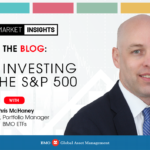
Commentary as of March 31st, 2024
Broad-based global equity indexes1 rallied in the fourth quarter, buoyed by growing consensus that the Federal Reserve (Fed) will lower rates in 2024. Now that consensus expectations have veered toward a soft landing, ARK continues to expect that a loss of pricing power will force corporations into employment cutbacks that will cause a harder-than-expected landing. Indeed, the US economy seems to have been in a rolling recession, depressing sectors like housing, autos, and commercial real estate while inventories continue to build. In response, the potential growth in ARK’s Five Innovation Platforms2 could play an outsized role in pulling the economy out of recession, salvaging corporate margins as inflation gives way to deflation in many sectors.
Rolling recessions suggest that the Fed should end its rate hiking program and weigh the merits of a pivot in policy. Unfortunately, the Fed still is focused on lagging indicators like employment and headline inflation. Indeed, the Bureau of Labor Statistics (BLS) has revised nonfarm payroll statistics down for eight of the last nine months, suggesting that the labor market is weaker than government reports have suggested. The last time that the BLS revised nonfarm payroll employment statistics down for such an extended period of time was in 2007, months before the onset of the Global Financial Crisis (GFC).
- The US auto industry faced significant challenges during the COVID-19 pandemic and, while sales did enter a V-shaped recovery in 2021, current unit sales are annualizing at a 15.8 million3 annual rate, still well below the pre-COVID range of 17-18 million units. In the early days of the pandemic, autos accounted for roughly one third of the inflation spike. Now, used car prices are down 15% year-over-year, down 21% from peak prices.4
- Housing metrics like median prices, housing starts, and affordability also are sending troubling signals. At 4.4 million units, the number of new and existing home sales in the US is approaching a level last seen during the global housing crisis. Rents for new tenants are declining roughly -4.6% year-over-year,56 a rate higher than at any point during the financial crisis in 2008-2009. At the same time, a record number of apartment units are under construction, suggesting that rent deflation will push inflation into much lower-than-expected territory over time.
- Real Gross Domestic Income (GDI)—which should equal real GDP over time—suggests that the US economy is meaningfully weaker than Real Gross Domestic Product (GDP). The near-record wide difference is ~$450 billion.7 Many global bellwethers are corroborating this weakness, several reporting year over-year revenue declines during the fourth quarter: 3M (-1.8%), UPS (-7.8%), Kraft-Heinz (-7.1%), Exxon Mobil (-12.3%), Thermo Fisher (-4.9%), Home Depot (-2.9%), Cisco (-5.9%), Texas Instruments (-12.7%). In other words, Europe, the UK, Japan, and China already are in or are bordering on recession.
- M29 growth still is down 3.0% on a year-over-year basis, a rate not seen since the 1930s.10 While sequential declines seemed natural after the COVID-related surge, continued weakness could be pointing to recession. Additionally, because rising mortgage rates have trapped homeowners in their homes, growth in the velocity of money seems to be slowing down, exacerbating the decline in M2 and raising the odds of broad-based price deflation.
While the Fed is focused on squelching inflation with higher interest rates, the bond market has been signaling trouble ahead. From March 2021 to July 2023, the yield curve11 inverted from +159 basis points to -108 basis points,12 hitting the steepest levels since the early 1980s when the Fed was fighting double-digit inflation. Since July 2023, the yield curve has entered a bear steepening phase, with long-term rates increasing relative to short-term rates, lowering the inversion to -39 basis points13 and suggesting that both real growth and inflation could surprise on the low side of expectations. The Federal Reserve began increasing interest rates when the year-over-year Consumer Price Index (CPI)—a lagging economic indicator—reached 8.5% on a year-over-year basis in March 2022. Shortly thereafter, an inflationary surge influenced by geopolitical pressures and inventory hoarding peaked at 9.1% year-over-year. Since then, CPI inflation has dropped to 3.2%,14 thanks to various deflationary forces––good, bad, and cyclical.
The Federal Funds Target Rate surged 24-fold in little more than a year. The deflationary ramifications of current Fed policy already are surfacing through bankruptcies in commercial real estate, both office and multi-family, and could culminate in another round of regional bank failures. If the Fed were to lower interest rates in response, companies sacrificing short-term profitability to invest and potentially capitalize on technologically enabled super exponential growth opportunities should be prime beneficiaries.
The Fed paused its tightening moves last summer. At the same time, in the technology realm, ChatGPT began to dramatize the seemingly miraculous breakthroughs that are likely to tip the scales even further toward broad-based deflation. Although creative destruction—the transition from gas-powered vehicles to electric vehicles, for example—could obfuscate the boom associated with AI and other disruptive technologies evolving today, the waves of growth associated with the convergence among the 14 technologies involved in our five major platforms—robotics, energy storage, AI, blockchain technology, and multiomics sequencing—should start moving the needle on macro metrics increasingly and significantly during the next five to ten years. In our view, history will show that inflation, initially triggered by supply shocks, was transitory and evolved into disinflation, then ultimately deflation. Consequently, interest rates are likely to surprise on the low side of expectations, broadening last year’s equity rally from a narrow subset of stocks
The BMO ARK Next Generation Internet Fund – ETF Series (ARKW) underperformed the S&P 500 Index while outperforming the MSCI World Index. Among the top detractors from ARKW’s performance were Roku (ROKU) and Unity Software (U). Shares of Roku slid after the company announced fourth-quarter earnings and Walmart acquired connected TV competitor, Vizio. Roku’s total revenue grew 11% year-over-year, surpassing expectations, and cash flow moved notably into positive territory. Total active accounts increased by 10 million, reaching 80 million and surpassing the combined subscriber count of the six largest traditional pay-TV providers. That said, now that Roku is expanding globally to meet consumer demand in lower-monetizing regions, average revenue per user was down by 4% yearover-year. While Walmart’s acquisition of Vizio will decrease shelf space for its TVs, Roku’s distribution is well-diversified, including other large retailers like Amazon, Best Buy, and Costco. Shares of Unity Software traded down after the company reported mixed fourth-quarter results, guiding to 3% year-over-year revenue growth at midpoint for the full year of 2024, well below Wall Street estimates of 9%. Interim CEO Jim Whitehurst is streamlining operations strategically with an intensified focus on sectors outside of the gaming space.
Among the top contributors were Coinbase Global (COIN) and ARK 21Shares Bitcoin ETF (ARKB). Shares of Coinbase Global rallied along with the broad crypto asset market. The price of bitcoin broke through $70,000, setting an all-timehigh in March, not long after the launch of 11 spot bitcoin ETFs. Coinbase also received positive news in its legal battle with the U.S. Securities and Exchange Commission (SEC) as the court dismissed the SEC’s charges against Coinbase Wallet, its self-custody solution—a significant win for Coinbase and for decentralized financial services in the US broadly. ARKB, an exchange traded fund that tracks the spot price of bitcoin (BTC), benefited from the same trends and from the upcoming “halving” of bitcoin—at which time its daily issuance will be cut in half—in April.
Invested in the highest conviction names in the Funds discussed above, the BMO ARK Innovation Fund – ETF Series (ARKK) underperformed broad-based global equity indices during the quarter. Among the top detractors from ARKK’s performance were Tesla (TSLA) and Roku (ROKU), for the reasons discussed above. Among the top contributors were Coinbase Global (COIN) and Robinhood Markets (HOOD), for the reasons discussed above.
1 As measured by the S&P 500 and MSCI World.
2 ARK’s Five Innovation Platforms are Artificial Intelligence, Robotics, Energy Storage, Multiomic Sequencing and Blockchain Technology.
3 WARD’s Automotive Group. Data as of March 31, 2024.
4 Manheim Used Vehicle Value Index. Data as of March 31, 2024.
5 National Associate of Realtors. Data as of February 29, 2024.
6 U.S. Bureau of Labor Statistics. Data as of December 31, 2024.
7 U.S. Federal Reserve Economic Data as of December 2024. GDP is the total market value of all finished goods and services produced within a country’s border within a specific time period, typically a year. GDI is a measure of the total income generated by a country’s economy within a specific time period, typically a year.
8 National Federation of Independent Business. Data as of March 2024.
9 M2 is a measure of the U.S. money stock that includes M1 (currency and coins held by the non-bank public, checkable deposits, and travelers’ checks) plus savings deposits (including money market deposit accounts), small time deposits under $100,000, and shares in retail money market mutual funds.
10 U.S. Federal Reserve Economic Data from January 1960 to December 2023. M2 prior to 1960 is calculated by adding Currency Held By The Public, Deposits Adjusted Commercial Banks, Bank Vault Cash, Monetary Gold Stock, and Deposits At Nonbank Thrift Institutions.
11 As measured by the difference between yields on the 10-year Treasury bond and the 2-year Treasury note.
12 An “inversion” means that the long-term Treasury yield is lower than the short-term Treasury yield. The yield difference was +159 basis points on March 29, 2021, and -108 basis points on July 3, 2023. One basis point is equal to 1/100 of a percentage point, or 0.01%.
13 The yield different was -39 basis points on March 28, 2024.
14 U.S. Bureau of Labor Statistics. Data as of February 29, 2024.
Disclosures:
This communication is intended for informational purposes only and is not, and should not be construed as, investment, legal or tax advice to any individual. Particular investments and/or trading strategies should be evaluated relative to each individual’s circumstances. Individuals should seek the advice of professionals, as appropriate, regarding any particular investment. Past performance does not guarantee future results.
The viewpoints expressed by the Portfolio Manager represents their assessment of the markets at the time of publication. Those views are subject to change without notice at any time. The information provided herein does not constitute a solicitation of an offer to buy, or an offer to sell securities nor should the information be relied upon as investment advice. Past performance is no guarantee of future results. This communication is intended for informational purposes only.
The portfolio holdings are subject to change without notice and only represent a small percentage of portfolio holdings. They are not recommendations to buy or sell any particular security.
Any statement that necessarily depends on future events may be a forward-looking statement. Forward-looking statements are not guarantees of performance. They involve risks, uncertainties and assumptions. Although such statements are based on assumptions that are believed to be reasonable, there can be no assurance that actual results will not differ materially from expectations. Investors are cautioned not to rely unduly on any forward-looking statements. In connection with any forward-looking statements, investors should carefully consider the areas of risk described in the most recent simplified prospectus.
Commissions, management fees and expenses (if applicable) may be associated with investments in mutual funds and exchange traded funds (ETFs). Trailing commissions may be associated with investments in mutual funds. Please read the fund facts, ETF Facts or prospectus of the relevant mutual fund or ETF before investing. Mutual funds and ETFs are not guaranteed, their values change frequently and past performance may not be repeated.
For a summary of the risks of an investment in BMO Mutual Funds or BMO ETFs, please see the specific risks set out in the prospectus of the relevant mutual fund or ETF. BMO ETFs trade like stocks, fluctuate in market value and may trade at a discount to their net asset value, which may increase the risk of loss. Distributions are not guaranteed and are subject to change and/or elimination.
BMO Mutual Funds are offered by BMO Investments Inc., a financial services firm and separate entity from Bank of Montreal. BMO ETFs are managed and administered by BMO Asset Management Inc., an investment fund manager and portfolio manager and separate legal entity from Bank of Montreal.
BMO Global Asset Management is a brand name that comprises BMO Asset Management Inc. and BMO Investments Inc.
“BMO is a registered trademark of Bank of Montreal, used under licence.












































